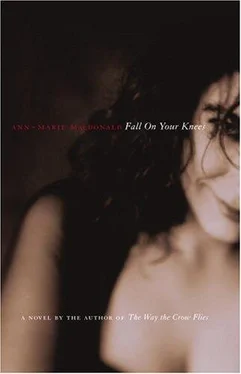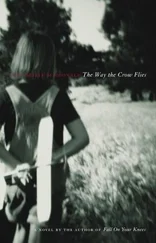Solace Art. Co. - 202 E. 44th St. N.Y.
Frances is going on six now. She has a number of questions regarding the mass card, but this is clearly not the time or place to raise them. Mercedes kneels next to her, crying and crying into her little white gloves, her hanky already drenched. Daddy’s face is frozen. If the wind changes it will stay that way for ever. Mrs Luvovitz, in a pew across the aisle, is crying behind her black veil. This is the first time Mrs Luvovitz has ever been inside a church. Mrs MacIsaac is there too, with dusty grapes on her hat. Frances decides the wind must have changed for her long ago. Filling in for Materia at the organ is Sister Saint Cecilia. Or at least it must be she within the flowing black robe beneath the Gothic skyline of starched white wimple. Frances thinks it logical that nuns wear cathedrals on their heads.
At the back of the church there is a phalanx of strangers. People with black curly hair, full features and smooth olive faces. These are some of Frances’s unknown relatives. Frances’s unknown Grandfather Mahmoud is not present. For him this funeral is redundant. Right now he’s locked in the back of his store, hunched on a plain wooden chair, apparently poring over a ledger.
Mr Benny-the-Butcher Luvovitz, Daddy and Mr MacIsaac are the pall-bearers. It’s all very much like Kathleen’s funeral a few days ago except for three things: Mumma was sitting at the church organ that day instead of lying in the box. And the scary old man who peered into Kathleen’s casket and muttered bad words in Mumma’s language, he’s not here. But most important, Frances has noticed at the very back, standing next to the dark little round woman with the grey bun, one tall lean figure: the dark lady who came with an envelope for Daddy and a candy for Frances a whole year and a bit ago. Teresa is here for some reason. Teresa the maid. Queen Teresa. Frances doesn’t listen when told to keep her eyes front, and has to be yanked around by Daddy, who will reserve proper punishment for home later on. If she hurries, perhaps Frances will be able to make it out of the church in time to run after the lady and hop into the taxi with her, never to return. They will drive off together into the land of black and white licorice peppermint rock candy.
“Eyes front!”
Frances is really going to get it after the funeral. She dares not sneak another look behind her at the woman of her dreams. So she concentrates on the mass card instead: ST AMBROSE . The name detaches itself from the card, leaving its holy prefix behind like a tail, and floats up into her mind, where it wafts about gently until it settles via some mysterious associative route upon the infant boy who died a few nights ago in her arms. Ambrose. Yes. That will be his name. Ambrose.
There have been three deaths in the space of one week at 191 Water Street. And two funerals. And three baptisms. And three burials. And two mass cards, identical, fill in the blanks. What a week. Enough to make you feel as though you’ve breathed laughing gas. And right now Frances wants very badly to laugh, she can’t tell why, except that it’s the single worst thing a person could do right about now. Oh no. Now that she has thought of laughing she can’t unthink it. She covers her face with her hands and grins. She tries to grin out the laughter. To exhale it silently, smoothly. But she starts to convulse and shake. She clamps her hands tighter against her face and gives in. She can no longer resist. It’s like the tide of pee when you’re outside playing and refuse to go inside and use the toilet — your water breaks and it’s both a blessed relief and the ultimate mortification.
Frances is spared the pee. But what could be worse than this outrageous hilarity at her mother’s funeral which comes two days after her sister’s funeral which came two days after all the baptisms and the death of — oh no, tears of laughter are darkening her white cotton gloves. Frances expects her father’s hand to grip the back of her neck, expects to be dragged in disgrace from the church. But what happens instead is a gentle pat upon her head — her father’s sympathetic hand, her sister’s offer of a sodden hanky. Frances is amazed. They think I’m crying .
Frances learns something in this moment that will allow her to survive and function for the rest of her life. She finds out that one thing can look like another. That the facts of a situation don’t necessarily indicate anything about the truth of a situation. In this moment, fact and truth become separated and commence to wander like twins in a fairy-tale, waiting to be reunited by that special someone who possesses the secret of telling them apart.
Some would simply say that Frances learned how to lie.
Of all her secrets, Ambrose was Frances’s biggest. He was also her greatest gift to Lily.
When the attic door finally gave way, James saw this silent portrait: Death and the Young Mother . It’s an overdone, tasteless, melodramatic painting. A folk painting from a hot culture. Naive. Grotesque. Authentic.
This is not a gauzy Victorian death scene. No fetishized feminine pallor, no agnostic slant of celestial light, no decorously distraught husband. This portrait is in livid colour. A crucified Christ hangs over a metal-frame single bed. On either side of the crucifix are two small pictures: one is of the Virgin Mary exposing her sacred heart aflame, the other is of her son Jesus, his heart likewise exposed and pierced to precious blood by a chain of thorns. They look utterly complaisant, Mother and Son. They have achieved a mutual plateau of exquisite suffering.
On the bed lies the Young Mother. Her eyes are closed. Her blonde-red hair is damp and ratty on the pillow. The sheets are black with blood. The centre of her body is ravaged. A plump dark woman who looks much older than thirty-three stands over her. This is the Grandmother. She holds two dripping infants trussed by the ankles, one in each hand, like a canny shopper guesstimating the weight of a brace of chickens. The Grandmother’s face looks straight out from the picture at the viewer.
If this were really a painting, there would also be a demon peering out from under the lid of the hope chest at the foot of the bed, looking to steal the Young Mother’s Soul. But he’d be pre-empted by her Guardian Angel waiting in the wings to guide her already departing Soul up to God. The Soul, half in, half out of the tomb of her body, is in very good condition, the hair freshly combed, the nightgown spotless, the face expressionless — the first divine divestiture has taken place, she has sloughed off her personality like an old skin. She won’t need it where she’s going. Above the crucifix, the wall has dematerialized. Clouds hover. Somewhere within is God, waiting.
But since this is not really a painting but a moment freeze-framed by James’s eye, the supernatural elements are, if present, invisible. There is the dead Young Mother, the Grandmother, the Infants, the Icons, the hope chest. What can you do with such a picture? You never want to see it again yet you can’t bring yourself to burn it or slash it to dust. You have to keep it.
Put it in the hope chest, James. Yes. That’s a good place for it. No one ever rummages in there . This is crazy, of course. You can’t stuff a memory of a moment into a real-life hope chest as if it were a family heirloom. But for a second James feels as though that’s what he’s looking at — an old portrait that he hid in the hope chest many years ago and just stumbled upon again. This temporary confusion is a premonition; it tells him that he will never get over this sight. That it will be as fresh fourteen years from now, the colours not quite dry, just as it is today.
Читать дальше












